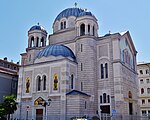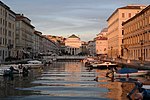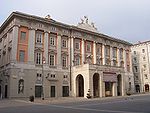Trieste National Hall
1920 in ItalyAnti-Slovene sentimentArt Nouveau architecture in ItalyBuildings and structures completed in 1904Buildings and structures destroyed by arson ... and 7 more
Buildings and structures in TriesteHistory of Slovenes in ItalyHistory of TriesteHotels in TriesteItalian FascismMax Fabiani buildingsSlovene national halls
The Trieste National Hall or Slovene Cultural Centre (Slovene: Narodni dom), also known as the Hotel Balkan, in Trieste was a multimodal building that served as a centre for the Slovene minority in the city. It included the Slovene theatre in Trieste, a hotel and numerous cultural associations. It is notable for having been burned in 1920 by Italian Fascists, which made it a symbol of the Italian repression of the Slovene minority in Italy. The building was restored from 1988 to 1990.
Excerpt from the Wikipedia article Trieste National Hall (License: CC BY-SA 3.0, Authors).Trieste National Hall
Via Fabio Filzi, Trieste Borgo Teresiano
Geographical coordinates (GPS) Address Website Nearby Places Show on map
Geographical coordinates (GPS)
| Latitude | Longitude |
|---|---|
| N 45.654722222222 ° | E 13.774722222222 ° |
Address
Narodni Dom
Via Fabio Filzi 14
34132 Trieste, Borgo Teresiano
Friuli-Venezia Giulia, Italy
Open on Google Maps










